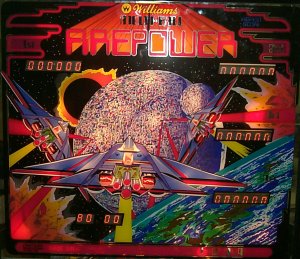|
Before
I get started, let me tell you that I think Firepower is just about the
best pinball game ever produced. Of
course, this is my personal opinion, and you may feel free to disagree
with me, but you’ll never change my mind.
Yes, I love “Medieval Madness” and would love to own one
someday (should have bought one when they were still going in the 3K range
<g>!), and I have a blast playing my NIB Stern’s.
However I find that anytime I’m down in the game room playing
pinball, I either always start or finish with a few games of Firepower.
I never get tired of Firepower, and I’ve been playing the one I
own now almost every day for 4 years.
Put
your “way-back” hat on and let’s travel back to 1980.
This was the “golden” era of the arcade.
Video games were all the rage, and pinball was still holding its
own.
Arcades
were about 50-50 video to pinball. EM
machines were still quite prevalent, and the solid state games released to
date were really nothing more than souped up EM games.
Bally had some decent titles, but most the early
Williams titles were nothing to write home about.
This was also the first wide body era, with
Williams releasing Stellar Wars and Pokerino, Bally had Space Invaders,
Stern had Flight
2000 and Big
Game, and Gottlieb had, well, forgettable Gottlieb titles.
Pinball was fun, but video games were capturing more and more of
the arcade quarters. 1979 saw
the introduction of continuous background sound (Flash) and Speech (Gorgar),
which foreshadowed the potential of the solid state pinball machine beyond
its current implementation as a transistorized EM machine.
I was
in my early 20’s in 1980, gainfully employed and had yet to buy a
personal computer. This meant
that my weekend evenings were spent at the arcades prior to hitting the
bars. The current arcade of
choice was the Malibu Grand Prix in
Mount Laurel
,
NJ
. It had two go-cart tracks, a
snack bar and about a 2,000 square foot arcade.
We would buy 5 laps, have some junk food, then play some games.
We’d do some video games, everybody was into Space Invaders and
the such, but we were still hardcore pinball players, having been raised
on the machines. Bally’s
Space Invaders was probably everybody’s favorite, followed by
Williams Flash. Games were
priced at 5 balls per quarter, so you were able to get some decent playing
time for your money.
Then at
the beginning of the summer of 1980, they put in a Firepower.
It was pinball love at first sight!
In keeping with Williams tradition of not paying for a license (remember Beat Time and Disco
Fever?),
Firepower was a direct rip-off of the Star Wars Death Star and x-wing
fighters. To this day the
backglass artwork in one of the most intricate designs every attempted.
The game was the coolest thing I had ever seen, and boy, was it
fast! It had everything, flash
lamps, multi-ball, speech and the coolest pinball sound every!
You want an adrenaline pump, how about the multi-ball countdown,
every muscle in your body tightened and your hair was on end waiting for
those balls to be ejected. We
would go in and line up three or four dollars worth of tokens on the
machine, effectively “reserving” the machine for ourselves for the
evening.
|
|
 /tr>
/tr>